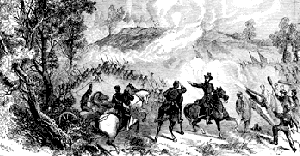









Gallery |
During the Snake Indian War, Pvt. Charles A. Fonda was mortally wounded at the skirmish of Otseo’s Lodge on April 28, 1868 against hostile Northern Paiute and Shoshone Indians near Warner Lakes, Oregon. Private Fonda was shot in the knee and since his wound was serious, it was decided to amputate his leg in the field. He did not survive the operation, and was almost certainly buried in the field. The site of the skirmish is known, but Fonda’s exact burial place is not. A government-issued headstone was placed at the site in July 2013. A newspaper account describes it as “a little east and south of the stone bridge.” The headstone was placed within 200 yards of the site of the stone bridge, on land that is on the Hart Mountain Antelope Refuge. The best description of the skirmish at Otseo’s Lodge is in the book ‘The Deadliest Indian War in the West: The Snake Conflict, 1864-1868‘ by Gregory Michno (p. 315): A Report of Surgical Cases treated in the Army of the United States from 1865 to 1871 by George Alexander Otis (p. 206): There are photos of Charles (as a boy) and his family on the Fonda Blog at Illinois Fonda’s. Thanks to John Griffin of Lakeview, Oregon for ordering and placing the military gravestone. References: Rootsweb, Find-A-Grave
The gravestone of E. Raymond Fonda at Albany Rural Cemetery, who gave his life in battle during the Civil War, has been restored.
The work scope was more extensive than planned because of the discovery of marble side rails in addition to the three-piece headstone and the footstone. Great care and expertise was taken by Joe Ferrannini of GSM, assisted by Civil War Historian Mark Bodnar (credits for photos). Thanks also to Colonie Historian Kevin Franklin for his interest and coordination efforts.
Eldert Raymond Fonda; b. 1837 in Watertown, MA; 1850 & 1860 Census, Edinburgh, Saratoga Co., NY; 1860 Census, Vergennes, Addison, VT; d. 7/22/1864 in New York City from wounds sustained in battle; bur. John Fonda Lot, Albany Rural Cemetery, Menands, Albany Co., NY; DAR Library, GRC National Index: Fonda, E Raymond, State IL, Series/Vol s1 v10, Page 175 Civil War Service: 1). E Raymond Fonda; Vergennes, Vermont; enlisted as a Private on 02-May-1861; enlisted in Co.G, 1st Infantry Regiment Vermont on 09-May-1861; mustered out Co.G, 1st Infantry Regiment Vermont on 15-Aug-1861 in Bradtleboro, VT; 2). E Raymond Fonda; enlisted as a Private on 21-Jul-1862 at the age of 24; enlisted in Co.H, 115th Infantry Regiment New York on 01-Aug-1862; POW on 15-Sep-1862 at Harper’s Ferry, VA; paroled on 16-Sep-1862 at Harper’s Ferry, VA; promoted to Full Sergeant MAJ on 16-Oct-1862; wounded on 07-May-1864 at Chester Station, VA; died of wounds Co.H, 115th Infantry Regiment New York on 22-Jul-1864 in New York, NY  Battle of Chesterfield Heights, Virginia - May 1864 Sgt.-Maj. Civil War; mortally wounded at Chesterfield Heights, VA on May 7th, 1864; born in Watertown, Mass., but resided in Cohoes, Albany county, when he enlisted in Co. H. He was a mechanic by trade, and twenty-four years of age. Besides the hard service seen in the 115th NY Infantry, he served his country three months in the 1st VT Infantry, early in the war. His father had been in the employ of the government for nearly forty years; a younger brother held the position of sergeant in the regular army, and Raymond himself had been familiar with military operations from his youth up, so that he was a finished and well drilled soldier. Possessed of a brave and resolute will, he was a good soldier. Blest with a kind and loving heart, he won many friends. Pleasant and amiable to both officers and men, he was highly respected. His military career was without a single blot, and he died a true patriot and esteemed by all who knew him. The battle of Chesterfield Heights, Va., was his last battle with the rebels. The regiment was lying behind a bank of earth, firing at the rebels, and Raymond refused to lie down with the rest, but kept walking along the lines while the bloody conflict was progressing, making his person a mark for the enemy’s bullets. Suddenly he sang out to the commanding officer, “Major, we are flanked right and left!” And sure enough we were flanked, and many brave men shed their blood before we cut our way out. Among the first to fall was E. Raymond Fonda, and two frightful wounds sent out streams of blood. The soldiers carried his bleeding form from the field, and in due time he reached the city of NY. After many weeks of suffering he died in the arms of his friends.  ...was treated in a field hospital until the 10th, when he was admitted into Hampton Hospital, Fort Monroe; thence transferred to New York, and admitted to Ladies' Home Hospital on the 23d of May. I did some more searching and found this (rather gruesome) account of Sgt-Major Fonda’s hospital treatment:  ... and the brave young soldier who saved the regiment was E. Raymond Fonda... And more on the battle where he was wounded: History of Cohoes: History of Saratoga County: True Stories of the War For the Union – Personal Experiences and Observations of Union Soldiers in the Several Campaigns: |